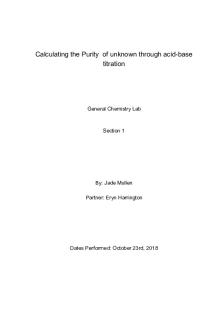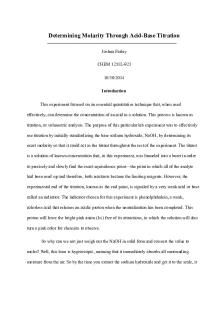Acid Base Titration - Chemistry 1210 Lab report containing an abstract, introduction, materials, procedure, PDF

| Title | Acid Base Titration - Chemistry 1210 Lab report containing an abstract, introduction, materials, procedure, |
|---|---|
| Course | General Chemistry II |
| Institution | New York City College of Technology |
| Pages | 6 |
| File Size | 256.9 KB |
| File Type | |
| Total Downloads | 6 |
| Total Views | 204 |
Summary
Chemistry 1210 Lab report containing an abstract, introduction, materials, procedure, data/results, questions/answers and conclusion....
Description
Chem 1210 Spring 2019 Experiment #10/11:Part 1 Acid Base Titration
Abstract: The purpose of this experiment is to observe the titration of hydrochloric acid, a strong acid with sodium hydroxide, a strong base and acetic acid, a weak acid with sodium hydroxide, a strong base. By observing the titration of a strong acid and strong base and a strong base and weak acid one can see how the shapes in the titration curves differ. One can also identify with pH indicator works best. Introduction: During titrations there is an equivalence point which is where equal amounts of moles of acid and base have been added. When graphed one can see a rapid change in the pH. The pH indicator used in this lab was phenolphthalein which is clear in acidic solutions and pink in basic solutions. Hydrochloric acid, a strong acid was used with sodium hydroxide a strong base. Strong acids and strong bases completely ionize in solution resulting in water and a salt. For a weak acid there's only partial ionization. The titration curve of a strong base/strong acid showed a stretched out curve as it started with a slow gradual change in pH as it reached the equivalence point. The titration curve of a strong base/weak acid showed a slow and gradual change in pH as it reached the equivalence point. Experimental Procedures: Materials: ● ● ● ● ● ● ● ● ●
0.10 M HCl 0.10 M NaOH 0.10M HC2H3O2 0.10 M NH4OH 250-mL beaker 50-mL buret 2 utility clamps Computer Distilled water
● ● ● ● ● ● ● ●
LoggerPro software Magnetic stirrer Magnetic stirring bar Phenolphthalein indicator Ring stand Vernier computer interface Vernier pH Sensor probe Wash bottle
Procedure: ** Safety precautions: Wear a lab coat and safety glasses. Handle HCl and NaOH with care. 1. 2. 3. 4. 5. 6. 7.
Place 8mLs of0.1 HCl into a 250mL beaker. Add 100mLs of distilled H20. Add 3 drops of acid-base indicator phenolphthalein. Place the beaker on the center of the magnetic stirrer and insert the magnetic stirring br. Turn on the stirrer and set the speed to slow. Suspend the pH sensor electrode on the ring stand using the utility clamp. Place the HCl solution and adjust its position so that the magnetic stirring bar doesn't hit the beaker. 8. Take a 50L buret, rinse it with 0.1 NaOH solution, then fill it to the 0.0mL mark.
9. Connect the ph sensor to the computer and on the loggerpro program open file 23: titration curves found in the chemistry with vener folder. 10. Record the pH of the solution. 11. Click collect and open the burret stop cock allowing it to drop at about 2 drops per second. 12. Record the time and ph when the color changes from clear to pink. 13. The clock will continues for 250 seconds, when it stops close the stopcock. 14. Label the point on the graph where the indicator changed colors. 15. Repeat the procedure using NaOH titrant and acetic acid solution. 16. Add 8mLs of 0.1m HC2H302 to a 250mL beaker. 17. Add 100mLs of distilled H20 and add 3 drops of the indicator. 18. Rinse the ph sensor and position it in the acid. 19. Repeat steps 9-14. 20. Drain the NaOH solution from the buret into the 250mL beaker. Dispose into the chemical waste and rinse the pH sensor. Discussion: Questions: 1. Which combinations of acid and base have the lower initial pH values? Are these the expected results? Why? Answer: Based on the data the strong acid/strong base combination of hydrochloric acid and sodium hydroxide had the lower initial pH value of 2.5. This value is expected because HCl is a strong acid and strong acids have a low pH. 2. For which acid-base combinations is the pH at the equivalence point neutral? Acidic? Basic? Are these the expected results? Why? Answer: Based on the data, the strong acid/strong base combination of hydrochloric acid and sodium hydroxide had the neutral pH at the equivalence point, being 7.11. This result is expected because a combination of strong acids and strong bases should result in a neutral at the equivalence point. For acetic acid and sodium hydroxide the pH at equivalence point is basic which is expected because a combination of a weak acid and strong base gives a basic pH basic at the equivalence point. 3. A good indicator changes color in the vertical region of the titration curve. Phenolphthalein changes from clear to red at a pH value of about 9. For which acid-base combinations is pH=9 on the vertical region? For which acid-base combinations does the time of the indicator color change and the time at the equivalence point agree? Are these two lists the same?
Answer: pH=9 is on the vertical region for the both the strong acid/strong base and weak acid/strong base titration. The time of the color change and the time at equivalence point do not agree. 4. On each of the four printed graphs, draw a horizontal line from a pH value of 9 on the vertical axis to its intersection with the titration curve. In which trial(s) does this line intersect the nearly vertical region of the curve? In which trial(s) does this line miss the nearly vertical region of the curve? Answer: The line intersects the vertical region of the curves for the acid base combinations on both graphs. 5. Methyl red is an acid-base indicator that changes color at a pH value of about 5. From what you learned in this lab, methyl red could be used to determine the equivalence point of what combination of strong or weak acids and bases? Answer: Methyl red couldnt be used to determine the equivalence point for the lab as the equivalence point for both titrations was 7+. It would only be good to used when determining the equivalence point of the strong acid and strong base because the pH range for vertical region of the curve for the weak acid and base is about 5. The pH range for vertical region of the curve for HCl and NaOH is about 3.5. 6. The acid-base reaction between HCl and NaOH produces a solution with a pH of 7 at the equivalence point (NaCl + H2O). Why does an acid-base indicator that changes color at pH 5 or 9 work just as well for this reaction as one that changes color at pH 7? Answer: An acid base indicator that changes color at pH 5 or 9 will work the same for the reaction between HCl and NaOH as one that changes color at pH 7, because the vertical region of the curve for strong acids and bases is longer with a pH range of around 3.5-10. 7. Of the four titration curves, which combination of strong or weak acids and bases had the longest vertical region of the equivalence point? What is the pH range of the longest vertical region? Which acid-base combination has the shortest vertical region? What is the pH range of the shortest vertical region? Answer: Of the two titration curves, HCl and NaOH had the longest vertical region of the equivalence point. HC2H3O2 and NaOH had the shortest vertical region and the pH values are about 5-10.
8. In general, how does the shape of a curve with a weak specie (NH4OH or HC2H3O2) differ from the shape of a curve with a strong specie (NaOH or HCl)? Answer: When comparing the curve of a weak specie with a strong specie, the strong specie’s curve is more sigmoidal. Data and Results: Data Table A: A table with data collected from the experiment consisting of things such as time, initial and final pH. Acid- Base Time of Time at PH at Initial PH Final PH Combinatio Indicator Color Equivalence Equivalence n Change (sec) Point (sec) Point HCl + Strong Acid 69 sec 104.5 sec 7.07 2.55 12.08 NaOH Strong Base CH3COOH + NaOH
Weak Acid Strong Base
69 sec
99.5 sec
Figure A1: The LoggerPro graph of the HCl and NaOH titration.
Figure A2: The excel graph of the HCl and NaOH titration.
8.74
2.91
11.89
Figure A3: The LoggerPro graph of the CH3COOH and NaOH titration.
Figure A4: The excel graph of the CH3COOH and NaOH titration.
Conclusion: From the data in table A1 and A2 and compare it to figure A3 and A4 we see that the NaOH HCl titration has the more sigmoidal curve. From the data in chart A we see that both the strong acid/strong base and the weak acid/strong base have a pH of 7+ at the equivalence point.
Bibliography Radivojevic Jovanovic, I. (2019). Log In ‹ Chem1210L — WordPress. [online] Openlab.citytech.cuny.edu. Available at: https://openlab.citytech.cuny.edu/chem1210l/titrationcurves-of-strong-and-weak-acids-and-bases-part-i/#Materials [Accessed 2 May 2019]....
Similar Free PDFs

Acid base titration lab report
- 5 Pages

Acid-Base Titration Lab Report
- 7 Pages

Acid-Base Titration Pre-Lab
- 4 Pages

Acid Base Titration
- 7 Pages

Acid Base Titration
- 15 Pages

Acid Base Titration
- 6 Pages

Afl Acid-Base Titration
- 6 Pages

Exp 08 Acid-Base Titration
- 10 Pages

Chemistry 1210 Lab 11
- 5 Pages

Acid Base Titration 08 2019
- 11 Pages
Popular Institutions
- Tinajero National High School - Annex
- Politeknik Caltex Riau
- Yokohama City University
- SGT University
- University of Al-Qadisiyah
- Divine Word College of Vigan
- Techniek College Rotterdam
- Universidade de Santiago
- Universiti Teknologi MARA Cawangan Johor Kampus Pasir Gudang
- Poltekkes Kemenkes Yogyakarta
- Baguio City National High School
- Colegio san marcos
- preparatoria uno
- Centro de Bachillerato Tecnológico Industrial y de Servicios No. 107
- Dalian Maritime University
- Quang Trung Secondary School
- Colegio Tecnológico en Informática
- Corporación Regional de Educación Superior
- Grupo CEDVA
- Dar Al Uloom University
- Centro de Estudios Preuniversitarios de la Universidad Nacional de Ingeniería
- 上智大学
- Aakash International School, Nuna Majara
- San Felipe Neri Catholic School
- Kang Chiao International School - New Taipei City
- Misamis Occidental National High School
- Institución Educativa Escuela Normal Juan Ladrilleros
- Kolehiyo ng Pantukan
- Batanes State College
- Instituto Continental
- Sekolah Menengah Kejuruan Kesehatan Kaltara (Tarakan)
- Colegio de La Inmaculada Concepcion - Cebu





